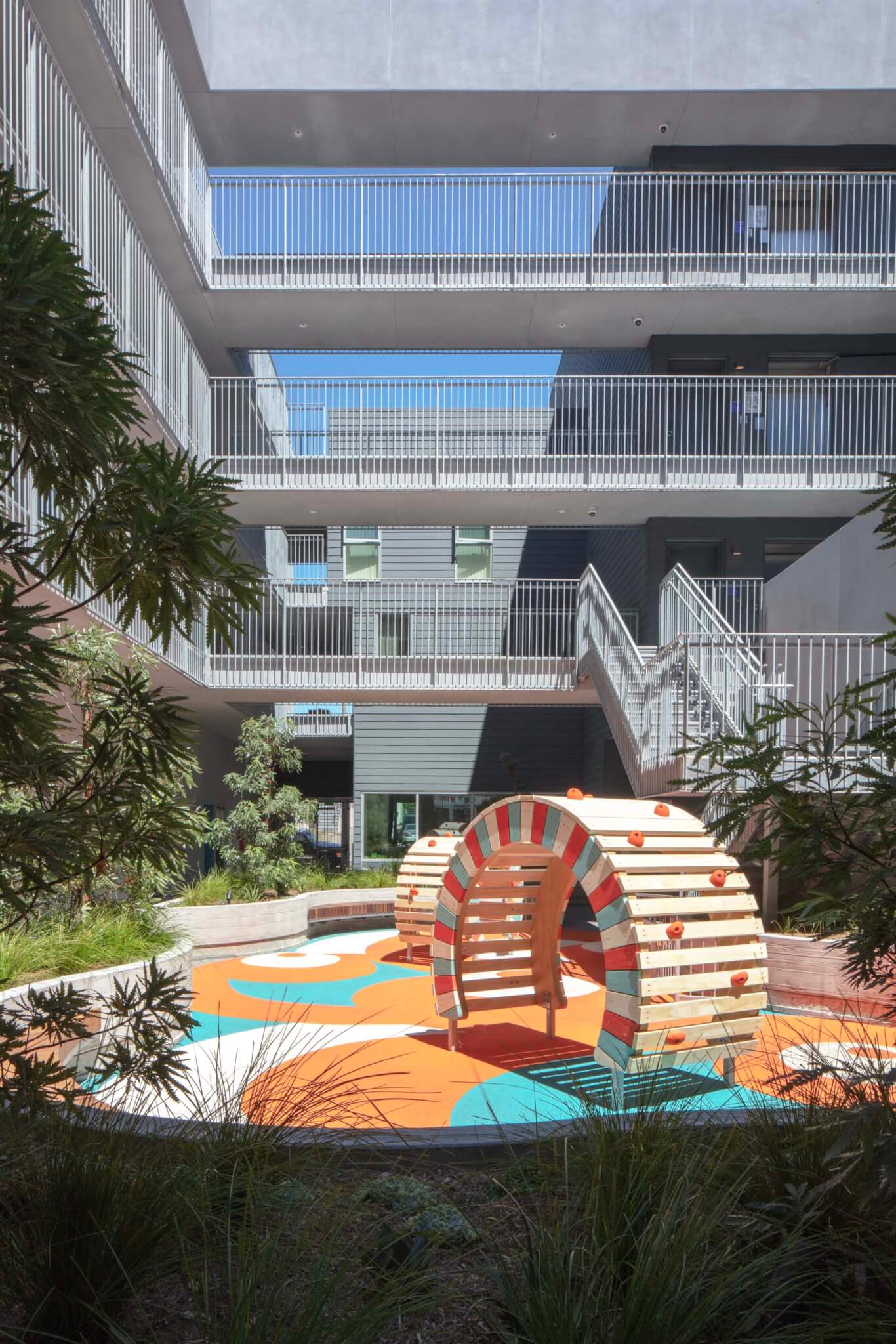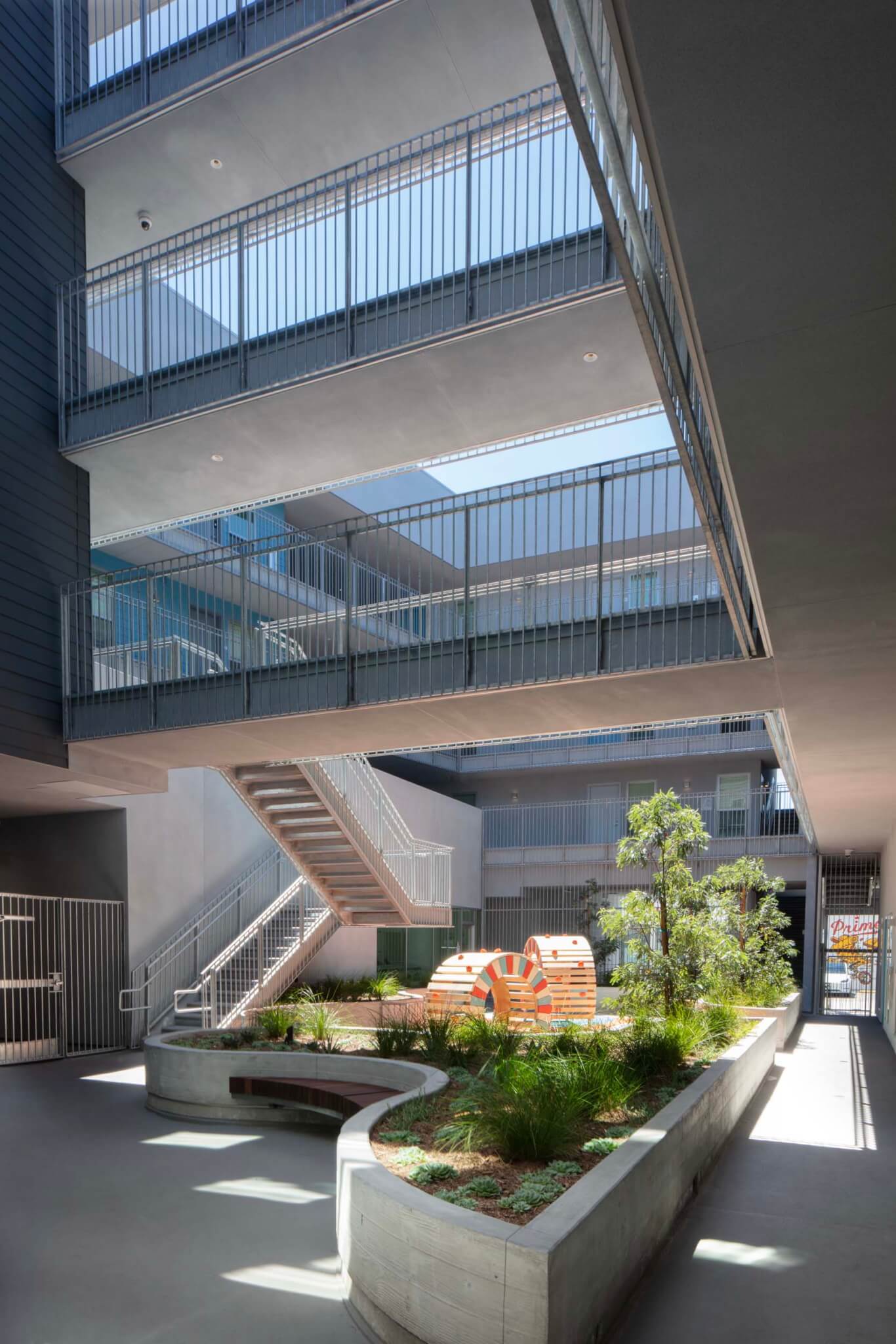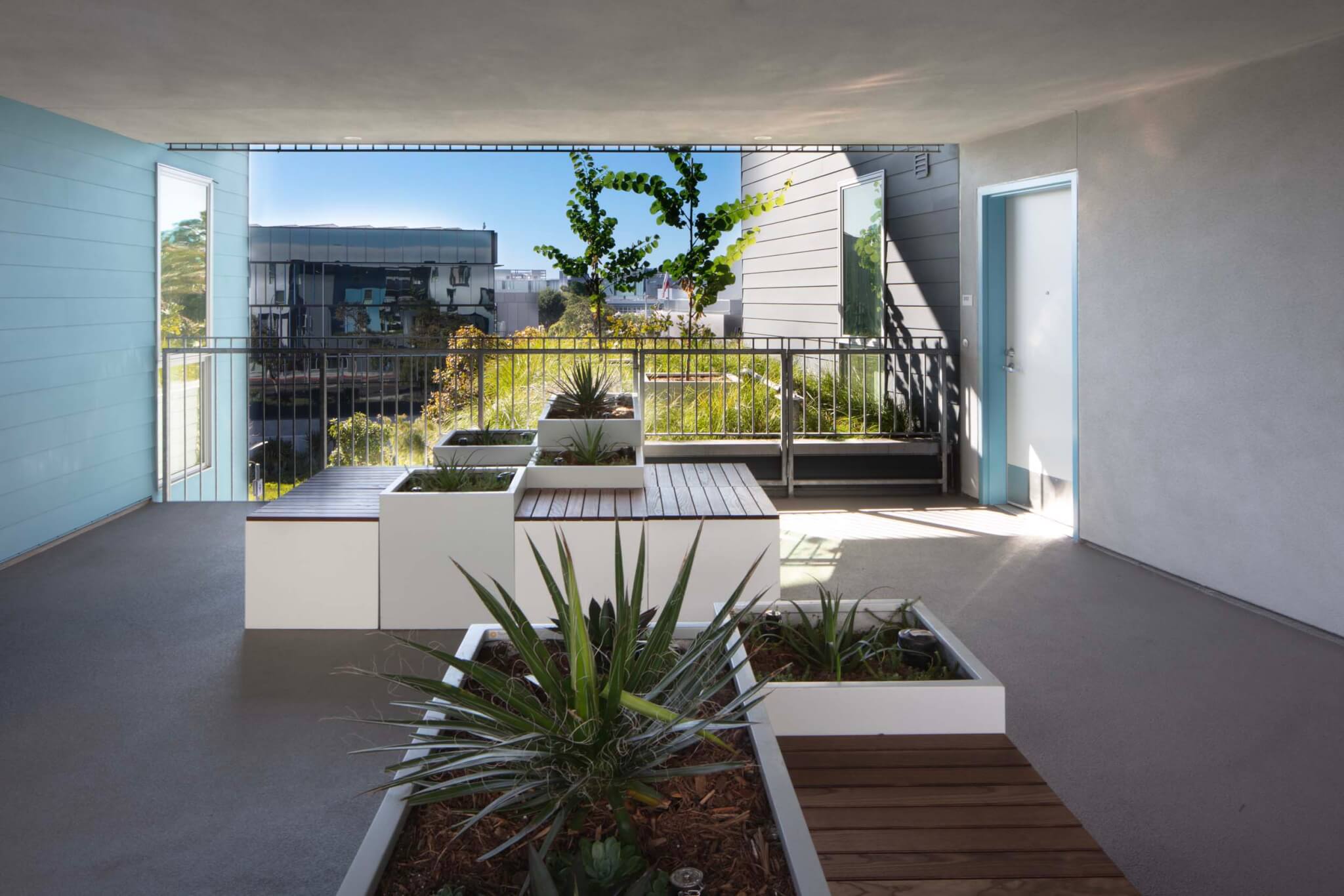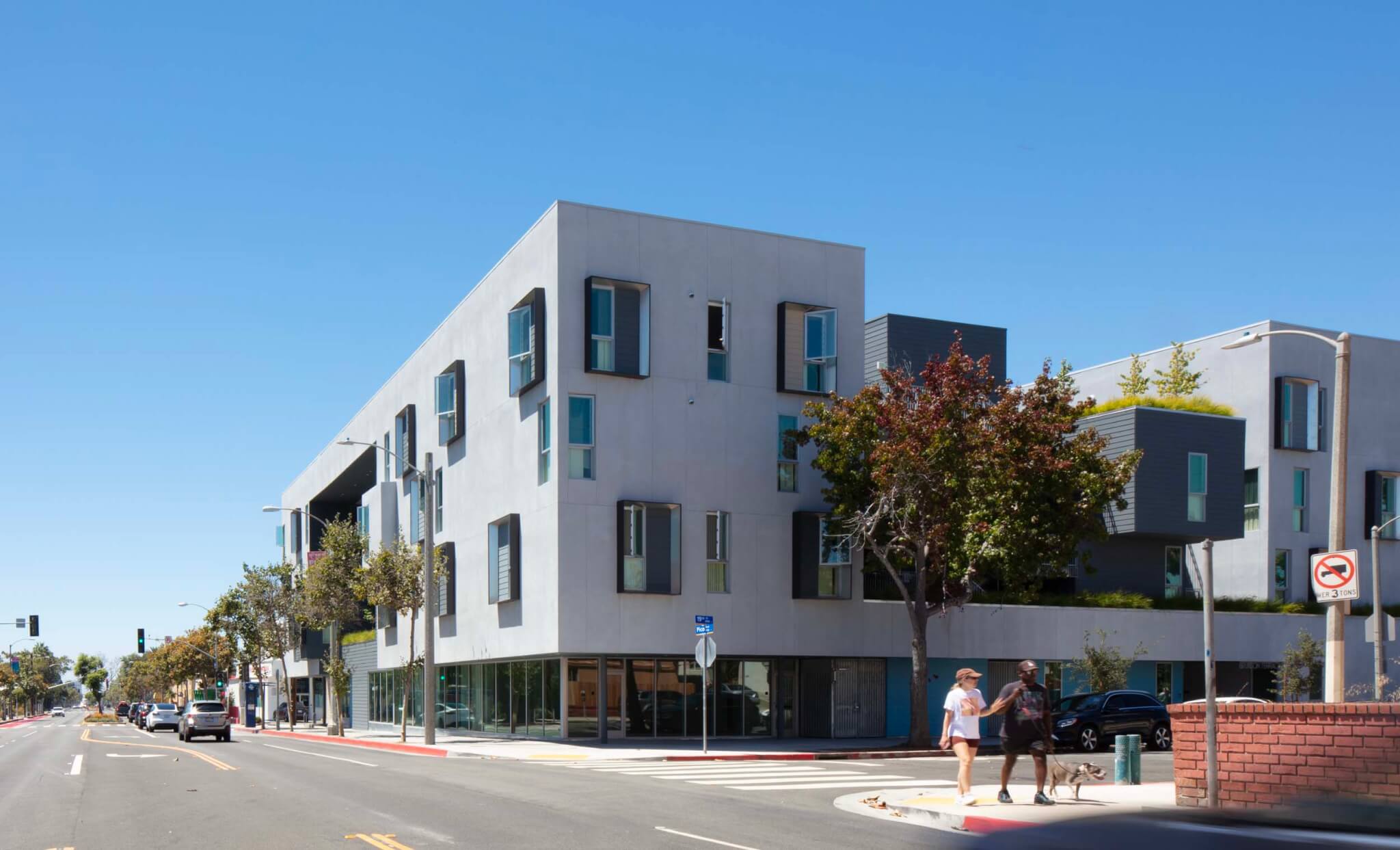Across the 4,751-square-mile region of Los Angeles County, the seaside city of Santa Monica has become the unrivaled testing ground for innovations in energy-conscious civic design in the service of community. It might just have at least one example for every building type imaginable. Frederick Fisher & Partners’s open-plan office addition to Santa Monica City Hall, for instance, was the first municipal structure to receive Living Building Challenge Certification. Field Operations’s adjacent Tongva Park, funded through California’s now-defunct tax increment financing (TIF) laws, is replete with drought-tolerant plants grown in local nurseries and watered by the runoff of a nearby recycling facility.
Brunson Terrace, a 48-unit affordable housing project recently completed across the street from Santa Monica College, continues this trend by boasting every energy-saving accolade one can reasonably expect. Designed by the Hawthorne, California–based firm Brooks + Scarpa, the LEED Platinum–status building achieves a Predicted Energy Use Intensity (pEUI) score of 6.6 thanks to a net-zero output—a true rarity for the building type.
Yet the architects drew just as much from the past for inspiration as from projections of future energy use. “The building’s massing—essentially a carved-out cube with strategic openings and a courtyard—belongs to a longer local history of courtyard apartments throughout Southern California ranging from Irving Gill’s 1918 Horatio Court to the classic post–World War II Spanish Colonial Revival Ambrose Gardens,” Angela Brooks, cofounder of Brooks + Scarpa, told AN. The ground floor is a quasi-public space animated by natural light, cross ventilation, and a colorful children’s play structure shielded from the roaring cars of Pico Boulevard by a street-facing community space and 6,700 square feet of ground-level retail.

The various sources of funding and subsidies for Brunson Terrace—including low-income housing tax credits from the State of California, funding from the City of Santa Monica (construction-to-permanent loan), and a loan from the Bank of America—were secured by the Community Corporation of Santa Monica, a local nonprofit founded in 1982 that now manages nearly 2,000 affordable housing units in the beachside city. Each of these financial sources, however, came with different requirements and concerns. Brooks + Scarpa therefore didn’t have many options regarding the layouts and finishes of the units. “The interiors of affordable housing units are the coding equivalent of sardines in a can,” said Lawrence Scarpa, cofounder of Brooks + Scarpa, “leaving us to squeeze in natural light, cross ventilation, and views where we could.”
The stair, however, was the subject of a harder-fought battle waged by the firm in pursuit of an open-air design that snakes across the courtyard and western elevation. “In the fire department’s ideal world, the stairs would be contained within an enclosed shaft to isolate potential fires from the rest of the building,” Scarpa explained. “But we see the stairs as a part of the lived experience of the affordable housing building type rather than an element of risk management or an afterthought.” The result of this regulatory battle is a dynamic interplay of circulation bridges, stairs, and balconies that maintain a visible connection to the ground-floor courtyard, allowing caretakers to watch over children in the play structure as they wash clothing in the stair-adjacent laundry room.

“As residents circulate vertically, they find smaller side spaces that allow for a variety of more passive activity,” said Brooks. “When you can view a green space or a street or social space, you feel closer to it, so the design allows multiple visual connections to these types of spaces, but also the ability to be physically separate from them, if one desires.” Scarpa added that “people will walk three stories without thinking about it” when the stairs are visible upon entering the courtyard, leading to the development of a small community.

The building’s LEED Platinum status, dynamic massing, and open stair design are additionally impressive considering that the construction cost was just under a staggering $800,000 per unit, which is still far below the $1 million price tag often seen in California, a product of the state’s skyrocketing property values and exorbitant contracting regulations associated with the building type. Yet the increasing cost of building affordable housing in Santa Monica brings an unavoidable question to light: How affordable is “affordable housing” when it’s developed in one of the wealthiest ZIP codes in America? Though the residents of Brunson Terrace rent for far below the local market rate (which, in Santa Monica, averages over $3,900 per month), the neighborhood amenities, resources, and transportation infrastructure predominantly cater to a clientele far above their means. Until enough affordable units and related resources pop up across the city to meaningfully offset local wealth disparity, Brunson Terrace will have to largely rely on its own internal community for what is missing just beyond its perimeter and Santa Monica will be a loose constellation of civic-minded projects in search of a direction forward.
Shane Reiner-Roth is a lecturer at the University of Southern California and the University of California, Los Angeles.
Project Specifications
-
- Architect: Brooks + Scarpa
- Landscape architect: Tina Chee with Brooks + Scarpa
- Structural/civil engineer: Labib Funk Engineering
- MEP engineer: Idiaz Design
- General contractor: United Building
- Masonry: Angelus Block Company
- Windows: Arcadia, Alpine, U.S. Aluminum
- Skylights: Bristolite, Solatube International
- Doors: TM Cobb, Timely, Steelcraft, McKeon Door Company, Nationwide Industries, Anemostat Door Products, Total Door Systems
- Hardware: Schlage, Trimco, LCN, Ives, Rixson, Monarch, Pemko, Johnson, Elmes
- Roofing: CertainTeed
- Tile: Walker Zanger
- Fixtures: American Standard, Kohler, Bobrick, Grohe, Chicago Faucets, Toto, Delta

